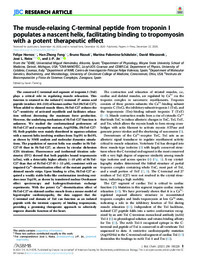Por favor, use este identificador para citar o enlazar este ítem:
https://hdl.handle.net/11000/35639Registro completo de metadatos
| Campo DC | Valor | Lengua/Idioma |
|---|---|---|
| dc.contributor.author | Hornos, Felipe | - |
| dc.contributor.author | Feng, Han-Zhong | - |
| dc.contributor.author | RizzutI, Bruno | - |
| dc.contributor.author | Palomino-Schätzlein, Martina | - |
| dc.contributor.author | Wieczorek, David | - |
| dc.contributor.author | Neira, José L. | - |
| dc.contributor.author | Jin, J.-P. | - |
| dc.contributor.other | Departamentos de la UMH::Agroquímica y Medio Ambiente | es_ES |
| dc.date.accessioned | 2025-02-14T08:06:26Z | - |
| dc.date.available | 2025-02-14T08:06:26Z | - |
| dc.date.created | 2020-12-22 | - |
| dc.identifier.citation | Journal of Biological Chemistry, Volume 296100228January-June, 2021 | es_ES |
| dc.identifier.issn | 1083-351X | - |
| dc.identifier.issn | 0021-9258 | - |
| dc.identifier.uri | https://hdl.handle.net/11000/35639 | - |
| dc.description.abstract | The conserved C-terminal end segment of troponin I (TnI) plays a critical role in regulating muscle relaxation. This function is retained in the isolated C-terminal 27 amino acid peptide (residues 184–210) of human cardiac TnI (HcTnI-C27): When added to skinned muscle fibers, HcTnI-C27 reduces the Ca2+-sensitivity of activated myofibrils and facilitates relaxation without decreasing the maximum force production. However, the underlying mechanism of HcTnI-C27 function is unknown. We studied the conformational preferences of HcTnI-C27 and a myopathic mutant, Arg192His, (HcTnI-C27-H). Both peptides were mainly disordered in aqueous solution with a nascent helix involving residues from Trp191 to Ile195, as shown by NMR analysis and molecular dynamics simulations. The population of nascent helix was smaller in HcTnI-C27-H than in HcTnI-C27, as shown by circular dichroism (CD) titrations. Fluorescence and isothermal titration calorimetry (ITC) showed that both peptides bound tropomyosin (αTm), with a detectably higher affinity (∼10 μM) of HcTnI-C27 than that of HcTnI-C27-H (∼15 μM), consistent with an impaired Ca2+-desensitization effect of the mutant peptide on skinned muscle strips. Upon binding to αTm, HcTnI-C27 acquired a weakly stable helix-like conformation involving residues near Trp191, as shown by transferred nuclear Overhauser effect spectroscopy and hydrogen/deuterium exchange experiments. With the potent Ca2+-desensitization effect of HcTnI-C27 on skinned cardiac muscle from a mouse model of hypertrophic cardiomyopathy, the data support that the C-terminal end domain of TnI can function as an isolated peptide with the intrinsic capacity of binding tropomyosin, providing a promising therapeutic approach to selectively improve diastolic function of the heart. | es_ES |
| dc.format | application/pdf | es_ES |
| dc.format.extent | 18 | es_ES |
| dc.language.iso | eng | es_ES |
| dc.publisher | Elsevier, American Society for Biochemistry and Molecular Biology | es_ES |
| dc.rights | info:eu-repo/semantics/openAccess | es_ES |
| dc.rights | Attribution-NonCommercial-NoDerivatives 4.0 Internacional | * |
| dc.rights.uri | http://creativecommons.org/licenses/by-nc-nd/4.0/ | * |
| dc.subject | troponin I | es_ES |
| dc.subject | muscle contractility | es_ES |
| dc.subject | peptide conformation | es_ES |
| dc.subject | computer modeling | es_ES |
| dc.subject | skinned cardiac muscle | es_ES |
| dc.subject | hypertrophic cardiomyopathy | es_ES |
| dc.subject.other | CDU::5 - Ciencias puras y naturales | es_ES |
| dc.title | The muscle-relaxing C-terminal peptide from troponin I populates a nascent helix, facilitating binding to tropomyosin with a potent therapeutic effect | es_ES |
| dc.type | info:eu-repo/semantics/article | es_ES |
| dc.relation.publisherversion | https://doi.org/10.1074/jbc.RA120.016012 | es_ES |

Ver/Abrir:
4 - 1-s2.0-S0021925820003439-main.pdf
3,27 MB
Adobe PDF
Compartir:
 La licencia se describe como: Atribución-NonComercial-NoDerivada 4.0 Internacional.
La licencia se describe como: Atribución-NonComercial-NoDerivada 4.0 Internacional.
.png)